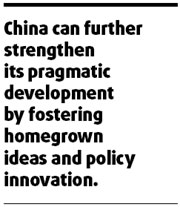Innovation key to sustainable growth
By Jeffrey Liang (China Daily)
Updated: 2008-04-03 07:29
Updated: 2008-04-03 07:29
Innovation is at the heart of sustainable growth and development. With innovation, labor earns higher wages, and growth can be environment-friendly sustained by less input of capital and natural resources.
This is why promotion of homegrown innovation has become a key pillar of China's development strategy. But what are the sources of innovation, and how to become an innovation nation?
Innovation captures the process through which knowledge and scientific invention turn into new products, or new institutional arrangements that improve efficiency or quality of services. Innovation so defined is inseparable from knowledge generation and dissemination and is fundamental to economic catch-ups for developing countries.
For most developing countries, economic openness has been the main source of knowledge and innovation. Through trade, foreign direct investment, and overseas studies, developing countries can learn, imitate and innovate at various speeds based on their knowledge absorption capacity and policy environment crucial to technology transfer.
China's economic miracle from this innovation perspective could be broadly characterized as success in leveraging economic openness for rapid knowledge absorption and creation, and for keeping up the momentum for reforms to widen the channels for knowledge transfer and for achieving policy goals such as balanced development.
Trade, FDI and overseas Chinese participation in the reforms process are undoubtedly all important factors in creating China's economic miracle and knowledge catch-ups.
Two-pronged strategy
However, innovation relying on openness has its limitation. Growth soon tapers when developing countries close the knowledge gaps with developed ones. Innovation sparked by openness may not take root and become "home-grown" if countries do not put in place a sound "innovation framework" and a culture of learning, knowledge-sharing, open debates, and independent research.
This is why not all developing countries embracing globalization create sustained growth and eventually join the league of industrialized ones. The reasons lie in the complexity of knowledge that makes its transfer and absorption less straightforward than commonly perceived.
Knowledge creates knowledge, and ideas generate new ideas. But between two kinds of knowledge, explicit and tacit, the latter is recognized as more important for innovation than the former but much harder to transfer from countries to countries and individuals to individuals.
Unlike explicit knowledge that can be learned through text books and communication, tacit knowledge is embodied in individuals that can only be acquired through apprenticeship, learning-by-doing, and managed interactions or networking among junior and senior staff within an organization.
This gives rise to the concept of "learning institutions" or "knowledge institutions" where incentives and opportunities are created for life-time-learning, and formal and informal learning networks are established to retain knowledge, distill new knowledge, and transfer knowledge among colleagues.

Of course, training and learning development should be an integral part of knowledge institutions' strategies to enhance the absorption and creation abilities of staff.
At the macro-level, an open and competitive environment needs to be nurtured for science research and development policy studies. Governments have a strong role in sponsoring and fostering research of public goods nature to complement research of proprietary nature that are increasingly undertaken or sponsored by corporations and other private entities.
Such an open and competitive environment is perhaps even more vital for studies of emerging policy issues, because not all new and untested ideas generated from studies represent progress in knowledge creation and innovation, and therefore whose applications in policy and institutional reforms may cause socio-economic regression rather than progression.
So for policymakers, it is always beneficial to hear competing policy advice and weigh the pros-and-cons of each policy option.
One lesson learned from China's development experience is perhaps policymakers' open-mindedness and pragmatism toward ideas and advice from "mainstream theories", and their uncompromised emphasis on applicability to innovative ideas.
This year marks the 30th anniversary of China's economic reforms and opening up initiated in 1978 by Deng Xiaoping. With the experience gained, China can further strengthen its pragmatic development by fostering homegrown ideas and policy innovation.
Promotion of phased separation and independence from "associations" or "think tanks" that are currently affiliated with various government ministries will greatly enhance China's innovative capacity and promote a competitive environment for policy research. This will ultimately make China a force to be reckoned with in global consulting services and the knowledge community.
An innovation nation needs a two-pronged strategy - nurturing a culture of life-time-learning at all levels of society, and fostering an environment for competitive science research.
The author is head of Programs Unit, Asian Development Bank's Resident Mission
(China Daily 04/03/2008 page9)
|
|
|
|